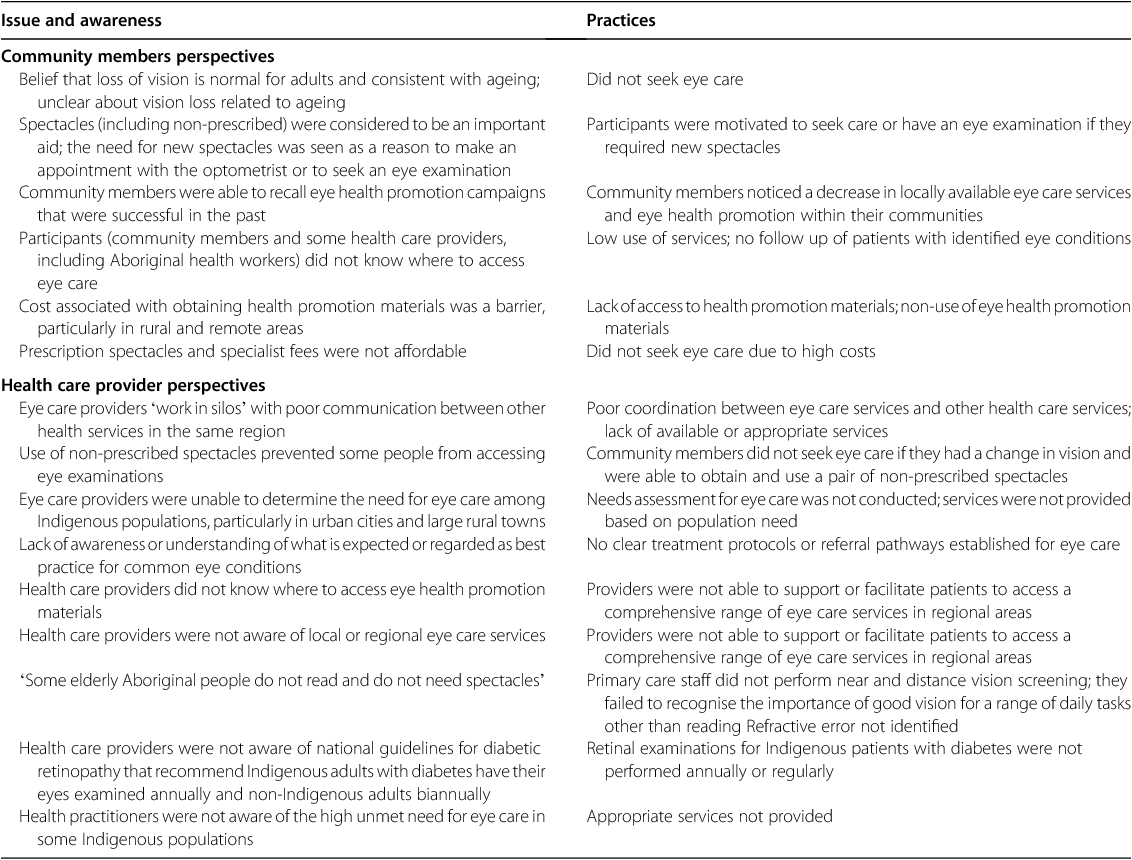Eye health promotion to improve awareness and prevent vision loss among Indigenous Australians
Andrea I. Boudville A B , Mitchell D. Anjou A and Hugh R. Taylor AA The University of Melbourne Indigenous Eye Health Unit, Melbourne School of Population and Global Health, Level 5, 207 Bouverie Street, Carlton, Vic. 3053, Australia.
B Corresponding author. Email: andrea@unimelb.edu.au
Health Promotion Journal of Australia 24(1) 76-77 https://doi.org/10.1071/HE12913
Submitted: 13 August 2012 Accepted: 22 September 2012 Published: 21 March 2013
Ninety-four per cent of the vision loss and blindness in Indigenous Australians is caused by conditions that are preventable with access to eye examinations and timely treatment.1 Vision loss causes significant loss to reported sense of well being and increases the risk of falls, depression and hip fractures, with those experiencing vision loss using more health services.2–4 More than one-third of Indigenous adults have never had an eye examination.1
Understanding the factors influencing the choice made by community members to seek care is important for planning and delivering eye care services. Understanding the challenges faced by health and eye care providers can inform future provision of eye care.
We consulted community members and health care providers on their perspectives about awareness of eye care issues and the impact this has on the use of eye services. Ten focus group discussions were conducted with 81 Aboriginal community members in seven communities in Victoria. A total of 289 semistructured interviews were conducted with staff from health services, government departments and non-government organisations in Victoria, Queensland, New South Wales, the Northern Territory, South Australia and Western Australia. Three stakeholder workshops were conducted with 116 participants. The participants’ responses about awareness, practices and impact on eye health care are summarised in Table 1. Policy recommendations based on consultation data were developed and published in The Roadmap to Close the Gap for Vision.5

|
Many health care providers are not aware of the unmet need for eye care among the Indigenous communities they serve, particularly in urban centres and larger towns in rural areas. The lack of awareness about available treatments for eye conditions and knowing how and where to access affordable eye services contributes to the low use of eye care. Although good eye sight is valued and is the most commonly self-reported health condition, seeking eye care often receives low priority against other health issues.6
More work is required to improve referral pathways, develop service directories and promote awareness of vision loss prevention among health care providers and health care users. As improvements in eye health systems occur, new health promotion initiatives will be critical to let people know that eye care is available and when to seek eye care.
With government support, a commitment to equity and improving the provision of eye care for Indigenous Australians, it is possible to construct a supportive environment that empowers communities to access eye care and improve eye health outcomes.
References
[1] Taylor HR, Keefe JE, Arnold AL, Dunn RA, Fox S. National Indigenous Eye Health Survey–Minum Barreng (Tracking Eyes). Melbourne: Indigenous Eye Health Unit, Melbourne School of Population Health in collaboration with the Centre for Eye Research Australia and the Vision CRC; 2009.[2] Klein BEK, Klein R, Lee KE, Cruickshanks KJ (1998) Performance-based and self-assessed measures of visual function as related to history of falls, hip fractures, and measured gait time: the Beaver Dam Eye Study. Ophthalmology 105, 160–4.
| Performance-based and self-assessed measures of visual function as related to history of falls, hip fractures, and measured gait time: the Beaver Dam Eye Study.Crossref | GoogleScholarGoogle Scholar | 1:STN:280:DyaK1c7gsFSjtg%3D%3D&md5=02e88f7fc53f4746e654ced88a78be47CAS |
[3] Vision 2020 Australia, Access Economics. Clear focus: the economic impact of vision loss in Australia in 2009. Report. Melbourne: Vision 2020 Australia; 2010.
[4] Ivers RQ, Cumming RG, Mitchell P, Attebo K (1998) Visual impairment and falls in older adults: the Blue Mountains eye study. J Am Geriatr Soc 46, 58–64.
[5] Taylor HR, Anjou MD, Boudville AI, McNeil RJ. The Roadmap to Close the Gap for Vision full report. Melbourne: Indigenous Eye Health Unit, Mebourne School of Population Health, The University of Melbourne; 2012.
[6] Australian Institute of Health and Welfare (AIHW). Access to health services for Aboriginal and Torres Strait Islander people. Catalogue no. IHW 46. Canberra: AIHW; 2011.

